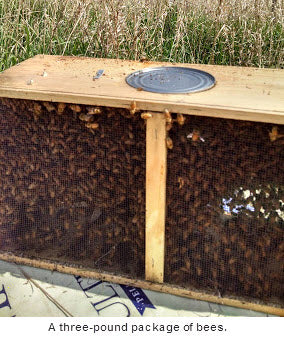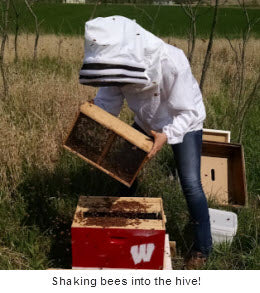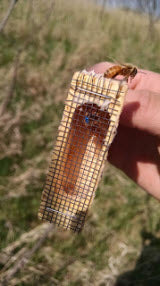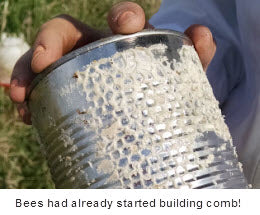
Bees in Boxes: How Did They Get In There?
Share
 "In a little over a month from now you'll be picking up your bees. Here's some helpful tips from the American Honey Queen - Buzzing Across America blog on what to do when you get YOUR BEES home! ~ Bill Lewis, Bill's Bees
"In a little over a month from now you'll be picking up your bees. Here's some helpful tips from the American Honey Queen - Buzzing Across America blog on what to do when you get YOUR BEES home! ~ Bill Lewis, Bill's Bees
You may have seen beehives near orchards or along fields in your area, but how did the honeybees get in there? Let’s take a look at how bees arrive in the spring and how they are transferred into the hive.
After a beekeeper has pre-ordered their honeybees for the year, they will get a phone call in spring saying the bees have arrived. They drive to the bee supply store to pick up their packages of honeybees. The packages are small wooden boxes with wire mesh on the sides and a can of sugar syrup hanging from the top. Depending on what size package the beekeeper ordered, there are either two pounds or three pounds of bees in the package. There are approximately 10,000 bees in a three-pound package, plus one queen bee in her own cage. This queen has recently been introduced to the bees in the package, which means they all need a few days to get to know each other. By the time the package arrives, all the bees have become accustomed to one another.
When the beekeeper gets the package of bees home, it is time to install it in the hive they have prepared. This is usually one deep hive body with frames inside. A deep hive body is the biggest box we can use for a hive. Frames are wooden frames with a sheet of beeswax or plastic with the honeycomb pattern molded into it, which offers a building guide for the bees to create wax honeycomb. Just like other types of farmers, different beekeepers might have different ways they take care of their animals. Here is one method to install the package of bees in the hive.


First, remove a few frames from the middle of the hive and set them aside. Remove the can of sugar syrup from the package. This can is usually empty because the bees were hungry on their truck ride to their destination! Slide the queen’s cage out of the package, make sure she is alive, and tuck her in your pocket for now. Pick up the package of honeybees, flip it over quickly, and start shaking the bees out into the middle of the box. The package can be tilted from side to side to help the bees shake out through the circular hole. Once almost all of them are out, set the package down near the hive. If there are still a few bees left inside, the package can be left near the hive until they find their way out. Next, gently return the frames to the hive. Be careful as you lower them into the box, making sure you are softly spreading the bees out and not squishing them. Once all the frames are back in the box, it’s time to release our queen! One way to release the queen is called direct release, meaning she will leave her cage immediately. Using the hive tool, the staple holding the wire mesh on the queen’s cage is removed. The wire mesh is held down with a finger until we are ready to release her. Lower the queen cage as deep as possible in the hive between two frames, then pull back the wire mesh from the front of the cage. Keep a close eye on the queen to make sure she walks out onto the frame and does not try to escape!
Next, gently return the frames to the hive. Be careful as you lower them into the box, making sure you are softly spreading the bees out and not squishing them. Once all the frames are back in the box, it’s time to release our queen! One way to release the queen is called direct release, meaning she will leave her cage immediately. Using the hive tool, the staple holding the wire mesh on the queen’s cage is removed. The wire mesh is held down with a finger until we are ready to release her. Lower the queen cage as deep as possible in the hive between two frames, then pull back the wire mesh from the front of the cage. Keep a close eye on the queen to make sure she walks out onto the frame and does not try to escape!
Put the inner cover on the hive. Many beekeepers will offer the bees sugar syrup after they first arrive to ensure they have a close source of food, especially if not many flowers are blooming and producing nectar. This is simply one part water and one part sugar mixed in a bucket. The bucket has tiny holes drilled in the lid, so when it is flipped upside-down the bucket will not leak continuously. This bucket feeder is placed partially over the hole in the inner cover. A medium box is placed around the feeder to protect it from weather, and the outer cover is placed on top of that.

At this point, our bees have been removed from their package and transferred to their new home. Once they find the food and are comfortable with their surroundings, they will get to work!
Thank you to Kim Kester and Tabitha Mansker, the American Honey Queen and American Honey Princess
